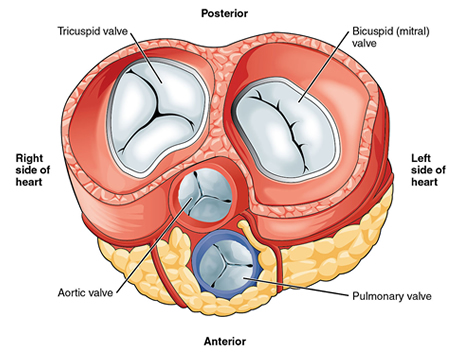Heart Valve Disease
The heart acts as a pump, supplying blood and essential nutrients to the other tissues of the body. In order that when the heart pumps the blood flows around the body in the correct direction a series of valves are needed in the heart. As with any valve the heart valves are there to open to allow blood to easily pass in the correct direction and then to close to prevent blood leaking backwards. This therefore means that there are only two conditions that affect heart valves, they either stop opening properly so the blood cannot flow forward (called stenosis) or they do not close properly and blood leaks backs (called either regurgitation or incompetence). Sometimes problems of the heart valves occur from birth (called congenital defects) and sometimes they develop over time.

Heart Valve Disease Symptoms
Since the degree of leakiness or narrowing of the heart valve can range from very mild to very severe there are a wide range of symptoms that can occur with heart valve disease. You may also often have no symptoms particularly if the narrowing or leakiness is mild. In this case the valve problem may only be detected by listening to the heart with a stethoscope and hearing a murmur (an extra heart sound during the heartbeat which should not be present). With more severe heart valve disease symptoms that can occur include
-
Breathlessness
-
Tiredness
-
An irregular or fast heartbeat (atrial fibrillation, AF)
-
Discomfort in your chest
-
Swollen feet and ankles
-
Feeling dizzy or faint
Causes of Heart Valve Disease
Some heart valve diseases are present from birth and are called congenital. These are only a small proportion of the total number of cases of heart valve disease.
Most heart valve disease is acquired. Until the last century rheumatic valve disease would have been the commonest form of acquired heart valve disease but the use of antibiotics to treat infections means that in the Western world this is now a rare cause of heart valve disease. In other parts of the world such as Africa rheumatic valve disease is still common. In particular it often leads to a narrowing of the mitral valve, called mitral stenosis.
More commonly valve problems now occur due to another disease of the heart such as a previous heart attack, a problem with the heart muscle (the cardiomyopathies) and heart failure.
The most common cause of heart valve disease is just wear and tear on the valves which develops with time over many years. Valve disease is becoming more common as the average age of the population increases.
Diagnosing Heart Valve Disease
Since, particularly with mild heart valve disease, the symptoms are often mild or there are no symptoms heart valve disease is often noticed after listening to the heart with a stethoscope and detecting a heart murmur. To look at the heart valve in more detail a test called an echocardiogram is performed. This uses an ultrasound probe placed on the chest to visualise the heart chambers and valves (transthoracic echocardiogram). Moving images of the heart can then assess the valves and the severity of the valve disease in detail. A gel is used on the surface of the chest to improve the contact of the ultrasound probe with the skin and improve the quality of the images. Sometimes the ultrasound probe is passed down the gullet to look at the heart under sedation (transoesophageal echocardiogram).
Other tests can be used to look at the heart valves such as an MRI of the heart or a CT but the use of these tests is uncommon in comparison to the use of echocardiograms.
Treating Heart Valve Disease
In general, if the heart valve is not severely diseased and you do not have many symptoms then heart valve disease is not treated. It is generally observed in outpatients on a regular basis and with the use of echocardiograms.
When the valve disease becomes more severe then treatment may be needed. This can either be to replace the valve or to repair it. To replace or repair the heart valve usually requires open heart surgery but new techniques to reduce the need for open heart surgery are being developed. For some valves a repair would be attempted first and the valve would only be replaced if a repair was not possible (this particularly applies to the mitral valve and mitral regurgitation).
There are some new techiques which do not require surgery. For some valves the valve can be passed via a tube inserted through the artery in the leg under X-ray guidance. This particularly applies to the aortic valve and is a procedure known as TAVI. Sometimes a leaky valve can be partially clipped together which reduces the amount of leakiness. This particularly applies to the mitral valve and is known as a mitraclip. An older technique which is sometimes used for narrowed valves is to stretch open the narrowed valve with a balloon inserted into either the vein or artery in the leg under X-Ray guidance. This is called a valvuoplasty.
